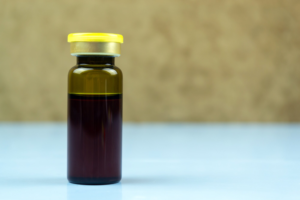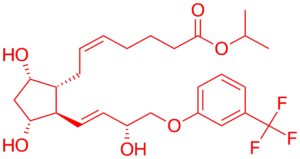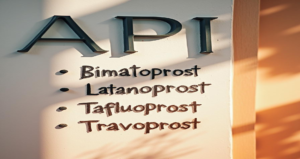
Glaucoma is a leading cause of irreversible blindness, primarily due to damage to the optic nerve caused by elevated intraocular pressure (IOP). Among various treatment options, prostaglandin analogs (PGAs) are the first-line therapy due to their superior efficacy in reducing IOP and their once-daily dosing convenience.
This article covers the most commonly used prostaglandin analogs, their benefits, available formulations, and the leading suppliers of active ingredients worldwide.
What Are Prostaglandin Analogs?
Prostaglandin analogs are topical eye drops that work by increasing the outflow of aqueous humor through the uveoscleral pathway, leading to IOP reduction. These medications have become the gold standard for glaucoma treatment because they are effective, well-tolerated, and have minimal systemic side effects.
List of Prostaglandin Analogs for Glaucoma & Their Activities
Several prostaglandin analogs are widely used in glaucoma management, each with unique properties. The table below highlights their primary activities and additional notes.
Table: Prostaglandin Analogs for Glaucoma & Their Activities
| Prostaglandin Analog | Brand Name | Primary Activity | Additional Notes |
|---|---|---|---|
| Latanoprost | Xalatan | Increases uveoscleral outflow | Most commonly prescribed PGA |
| Bimatoprost | Lumigan | Enhances both uveoscleral and trabecular outflow | Also used for eyelash growth (Latisse) |
| Travoprost | Travatan Z | Improves aqueous humor outflow | Preservative-free formulation available |
| Tafluprost | Zioptan | Increases uveoscleral outflow | Preservative-free formulation |
| Unoprostone | Rescula | Enhances outflow via trabecular meshwork | Less effective than other PGAs |
| Latanoprostene Bunod | Vyzulta | Increases uveoscleral and nitric oxide-mediated outflow | Dual mechanism for IOP reduction |
Benefits of Prostaglandin Analogs
Prostaglandin analogs offer significant advantages over other IOP-lowering treatments.
- Strong IOP-Lowering Effect – Reduces IOP by 25-35%, making them more effective than beta-blockers.
- Convenient Once-Daily Dosing – Improves patient treatment adherence.
- Minimal Systemic Side Effects – Unlike beta-blockers, PGAs primarily affect the eye.
- Alternative for Beta-Blocker Intolerant Patients – Suitable for individuals with asthma or cardiovascular issues.
- Preservative-Free Options Available – Beneficial for patients with dry eye syndrome.
Formulations of Prostaglandin Analog Eye Drops & Their Ingredients
Prostaglandin analogs are available in various ophthalmic formulations, either as single-agent drops or fixed-combination formulations.
Table: Formulations of Prostaglandin Analog Eye Drops & Their Ingredients
| Drug Name | Brand Name | Active Ingredient | Preservatives & Excipients |
|---|---|---|---|
| Latanoprost | Xalatan | Latanoprost 0.005% | Benzalkonium chloride (BAK), sodium chloride, water, pH adjusters |
| Bimatoprost | Lumigan | Bimatoprost 0.01% or 0.03% | BAK, sodium chloride, citric acid, water |
| Travoprost | Travatan Z | Travoprost 0.004% | Sofzia (preservative-free alternative), boric acid, mannitol, water |
| Tafluprost | Zioptan | Tafluprost 0.0015% | Preservative-free, includes polysorbate 80, glycerin, and pH adjusters |
| Unoprostone | Rescula | Unoprostone isopropyl 0.15% | BAK, sodium dihydrogen phosphate, water |
| Latanoprostene Bunod | Vyzulta | Latanoprostene bunod 0.024% | BAK, boric acid, mannitol, pH adjusters |
Major Suppliers of Active Ingredients Worldwide
Several pharmaceutical companies manufacture and supply active pharmaceutical ingredients (APIs) for prostaglandin analogs.
Explore a leading manufacturer of APIs.
With over 10 years of expertise, we ensure GMP compliance and provide reliable, high-quality solutions.
Table: Major Suppliers of Active Ingredients for Prostaglandin Analogs
| Active Ingredient | Major Suppliers (Worldwide) |
|---|---|
| Latanoprost | Chemignition Laboratory, Cayman Chemical, Merck KGaA, Pfizer API, Johnson Matthey, |
| Bimatoprost | Towa API, Chemignition Laboratory, Cayman Chemical, Allergan (AbbVie) |
| Travoprost | Chemignition Laboratory, Merck KGaA, LGM Pharma, Cayman Chemical |
| Tafluprost | Chemignition Laboratory, Cayman Chemical, Merck KGaA, LGM Pharma |
| Unoprostone | Bausch + Lomb, LGM Pharma, Merck KGaA |
| Latanoprostene Bunod | Chemignition Laboratory, Pfizer API, Cayman Chemical, Johnson Matthey |
Future of Prostaglandin Analogs in Glaucoma Treatment
The development of next-generation prostaglandin analogs and sustained-release implants is underway to improve patient compliance and treatment efficacy. Some promising advancements include:
- Sustained-Release Implants – Examples like Durysta (bimatoprost implant) eliminate the need for daily drops.
- Gene Therapy – Research is ongoing to modify prostaglandin receptor pathways for improved aqueous humor outflow.
- Advanced Drug Delivery Systems – Nanoparticles and gel-based formulations are being explored to enhance drug retention in the eye.
With glaucoma cases projected to rise globally, prostaglandin analogs will remain a primary treatment while innovations improve convenience and effectiveness.
Final Thoughts
Prostaglandin analogs play a vital role in glaucoma management, offering significant IOP reduction, convenient dosing, and preservative-free options. The most used drugs, including latanoprost, bimatoprost, travoprost, tafluprost, and latanoprostene bunod, continue to improve patient outcomes worldwide.
With a strong global supply chain from top pharmaceutical manufacturers and active ingredient suppliers, these medications remain widely accessible.
Chemignition Laboratory is a globally trusted manufacturer and exporter of high-quality Prostaglandins Active Pharmaceutical Ingredients (APIs).
We specialize in ophthalmic APIs and provide complete documentation support including,
- GMP Certificate
- ISO 9001 Certificate
- COA
- MSDS
- Stability Data
- Impurity Profile
- Customized packaging
- Cold chain logistics
- Safe delivery of sensitive APIs
We proudly supply high-quality Active Pharmaceutical Ingredients (APIs) to pharmaceutical companies around the world.
Partner with Chemignition Laboratory for consistent quality, regulatory compliance, and reliable global delivery.
Contact us at www.chemignition.com
FAQs
What are prostaglandin analogs used for in glaucoma treatment?
Prostaglandin analogs help lower intraocular pressure (IOP) by increasing the outflow of aqueous humor, reducing the risk of optic nerve damage in glaucoma patients.
Which prostaglandin analog is most commonly prescribed for glaucoma?
Latanoprost is the most commonly prescribed prostaglandin analog due to its high efficacy, once-daily dosing, and minimal side effects.
What are the side effects of prostaglandin analog eye drops?
Common side effects include eye redness, darkening of the iris, increased eyelash growth, and mild eye discomfort. Serious side effects are rare.
Where can I find reliable suppliers of prostaglandin analog active ingredients?
Leading suppliers include Chemignition Laboratory, Cayman Chemical, Merck KGaA, and Pfizer API, providing high-quality prostaglandin APIs globally.



